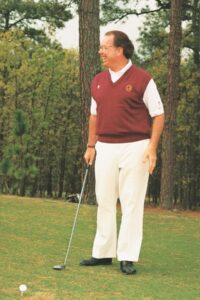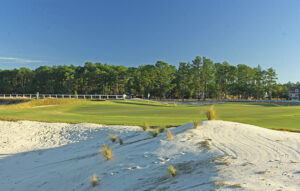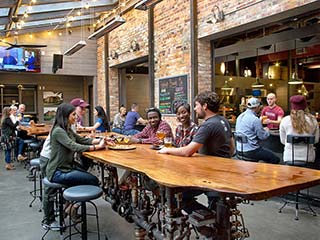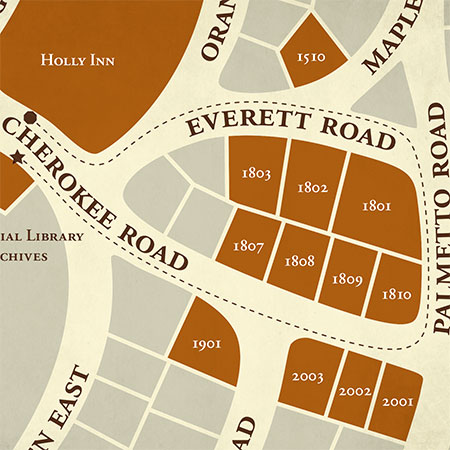Architect’s Mosaic
Architect’s Mosaic
By Lee Pace
The phone call from Pinehurst was a seminal event in the design careers of many of America’s top architects.
 “Getting the No. 6 job was a major step for us in the golf-design business,” Tom Fazio says of the mid-1970s assignment to build the resort’s first course away from its core operation in the Village of Pinehurst. “There was next-to-nothing new built in 1974 and ’75. Then the call came from Pinehurst.”
“Getting the No. 6 job was a major step for us in the golf-design business,” Tom Fazio says of the mid-1970s assignment to build the resort’s first course away from its core operation in the Village of Pinehurst. “There was next-to-nothing new built in 1974 and ’75. Then the call came from Pinehurst.”
“To get a plum job like No. 7 and have it so well-received was a turning point for me,” Rees Jones remembers of his mid-1980s assignment to create the signature amenity in a new housing development called the Fairwoods-On-7.
And though Bill Coore and Ben Crenshaw were well-established in the design world by 2010 when they were recruited to restore No. 2 to its mid-1900s strategic and aesthetic apex, the assignment was certainly a feather in their resume cap.
“To be asked to contribute our ideas here is a high, high honor,” Crenshaw said. “We think the world of Pinehurst. Beyond the golf, the feeling of the place, it means so much to American golf. From the turn of the century, it has always been a leader, and it always will. It’s been a mecca.”
Pinehurst became this mecca through a series of providential events — a man from Boston named James Tufts creating the village, lodging and recreational facilities in the late 1800s and then hiring a native of Scotland in 1900 to run his burgeoning golf operation.
Donald Ross felt an immediate kinship with the sandy soil structure of Moore County and its similarities to the landforms of his hometown of Dornoch and the site of his golf apprenticeship at St. Andrews.
“He was particularly attracted to the soil conditions here, as they reminded him of the old links land at home,” said Richard Tufts, grandson of the resort founder. “Even our native wire grass seemed to remind him of the whins he knew in Scotland.”
 Pinehurst had four courses designed by Ross by 1919 and the resort was the anchor for the Sandhills area to grow and expand. Over a century, nearly every noted architect in golf has added to the mosaic of the golf mecca that has nearly 40 courses within a 25-mile radius of the Village.
Pinehurst had four courses designed by Ross by 1919 and the resort was the anchor for the Sandhills area to grow and expand. Over a century, nearly every noted architect in golf has added to the mosaic of the golf mecca that has nearly 40 courses within a 25-mile radius of the Village.
Beyond his work at Pinehurst, Ross ventured to Southern Pines to design Southern Pines Golf Club (1912), Mid Pines (1921) and Pine Needles (1928). All three courses are owned under the same umbrella and have been restored and upgraded in recent years by the hand of architect Kyle Franz to maintain the Ross flavor and offer the finest modern agronomic conditions.
“This is just such a great property,” Franz says of the Southern Pines course that reopened in 2021. “I personally think it’s the best piece of topography on the ground of any of the courses in Pinehurst. So, for us, it’s a dream come true.”
Frank Maples was Ross’s right-hand man in construction and course maintenance the first half of the 20th century, and son Ellis went into course design and has five courses in the Sandhills. Frank designed Pinehurst No. 5 in 1961, then collaborated with landscape architect Willard Byrd on the Dogwood Course at the Country Club of North Carolina in 1963. He also designed 36 holes at the Country Club of Whispering Pines and 18 at Whispering Woods Golf Club.
 Ellis’s son, Dan, carried the family baton into the third generation with his design at Longleaf Golf & Family Club, located midway between Pinehurst and Southern Pines. The course is built on the site of a former horse training estate and is home to the U.S. Kids Golf Academy.
Ellis’s son, Dan, carried the family baton into the third generation with his design at Longleaf Golf & Family Club, located midway between Pinehurst and Southern Pines. The course is built on the site of a former horse training estate and is home to the U.S. Kids Golf Academy.
The Sandhills golf inventory popped beginning in the late 1980s when the United States economy was strong and developers latched onto two ideas that caught healthy trends: residential communities built around golf courses and stand-alone daily fee facilities.
Gene Hamm and Gary Player designed the two courses at Pinewild Country Club, the first opening in 1989 and the latter in 1996. Jack Nicklaus’s Pinehurst National opened in 1989 (it’s now Pinehurst No. 9), and Arnold Palmer’s Mid South Golf Club located next door on Midland Road followed in 1994. Two courses opened in the fall of 1991, just in time for the Tour Championship at Pinehurst No. 2 — Rees Jones’ Talamore Golf Resort and Jack Nicklaus II’s Legacy Golf Links.
 The No. 6 course design helped get Tom Fazio established to take over from his uncle George by the early 1980s, and Tom was at the height of his game as one of America’s preeminent golf architects when he was tapped to build 36 holes at Forest Creek Golf Club, the South Course opening in 1996 and the North in 2005. Club developer Terry Brown put all his eggs in the Fazio basket rather than hiring two designers, Fazio assuring Brown he could produce contrasting designs. Fazio did exactly that, with the South course featuring a burnished green, Augusta look and the North more a raw, unkempt design in the mold of Pine Valley.
The No. 6 course design helped get Tom Fazio established to take over from his uncle George by the early 1980s, and Tom was at the height of his game as one of America’s preeminent golf architects when he was tapped to build 36 holes at Forest Creek Golf Club, the South Course opening in 1996 and the North in 2005. Club developer Terry Brown put all his eggs in the Fazio basket rather than hiring two designers, Fazio assuring Brown he could produce contrasting designs. Fazio did exactly that, with the South course featuring a burnished green, Augusta look and the North more a raw, unkempt design in the mold of Pine Valley.
John Dempsey, a member since the late 1990s, says he tends to think of the courses as “cousins rather than sisters.”
“The South, you can plunk yourself in the middle of the seventh hole or 12th hole and you’d think you were at Winged Foot,” Dempsey says. “The North, you could plunk yourself in the middle of the 12th hole and you’d think you were playing Sutton Coldfield in England. So, they are quite different.”
The sandy loam unites all the courses in the Sandhills. The designers’ imaginations set them apart.
Chapel Hill based writer Lee Pace has written about golf in the Sandhills since the late 1980s and has authored a dozen books about clubs, courses and the people who’d made it special over more than a century.




